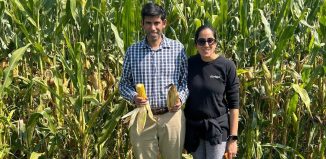BNL’s Wei-Fu Chen: developing a hydrogen-based fuel
Finding an inexpensive catalyst to break water down to its components is the key
It often looks like an outline of Mickey Mouse’s head, with a large circle and two overlapping or attached smaller circles. Drawn in a chemistry class, the larger circle is oxygen, while the two smaller ears are hydrogen.
In plants that produce their own food through photosynthesis, taking apart the three circles helps them make food, such as sugars. Scientists like Wei-Fu Chen at Brookhaven National Laboratory are imitating nature by breaking apart, or electrolyzing, water, releasing hydrogen that could serve as an alternative to fossil fuels.
“This process mimics how plants convert sunlight and nutrients into sugars,” said Chen.
As the lightest element, hydrogen has the highest gravimetric energy density of any known fuel, which means it produces the highest energy of all the elements.
Scientists can reduce the effort it takes to split water by using a catalyst. While platinum and palladium have fulfilled that role, they are expensive, which makes them less viable long-term options.
Chen suggested twin high school students Shilpa and Shweta Iyer from Comsewogue High School, who were working in his lab, go home and search their kitchen for ingredients that, using much more cost-efficient substances like metal carbide and metal nitride, might become a catalyst alternative. In the presence of molybdenum, soybeans, which are rich in proteins, worked. The 17-year-old Iyer twins recently placed fourth in the chemistry category of the Intel International Science and Engineering Fair for their efforts (see related story in the Port Times Record and online).
So far, in tests with soybeans, the catalyst has continued to be effective for over 500 hours. The production process, Chen said, is mature for industrial applications, with a projected cost that is “fairly economical” compared to other options. For commercial use, however, tests may need to take at least a year. Chen is searching for collaborators and would like to transfer the technology to an interested commercial partner.
Now that his lab has developed a process that works, Chen said that the next steps involve understanding the chemical mechanism that enables soybeans to act as a catalyst in the electrolysis of water.
“We don’t know why it’s so active,” he explained. “My job is to figure out the mechanism in the solution.”
Chen is able to tap into the considerable resources at BNL, including the National Synchrotron Light Source. By shooting beams of light through the reaction, Chen has found information about the catalytic active center and how the applied voltage changes its electronic state. He plans to study how changes in some of the conditions, such as the temperature or the pH (whether the solution is more of an acid or a base) affect the process.
The NSLS beams can allow scientists to monitor changes that occur in an incredibly short time scale, which makes it possible to track small changes in the reaction.
“By knowing the reaction mechanisms, scientists will be able to predict new effective structures for the water electrolysis and may find new principles in the reaction,” Chen suggested.
Chen explained that developing a hydrogen fuel-based economy remains a challenging task. While he is working hard to develop ways to make hydrogen fuel more available through water electrolysis, other scientists are researching the problem of storing and transporting hydrogen.
“The coming hydrogen age will be based on the completion of production, delivery, storage and utilization,” Chen said.
Chen said some hydrogen-driven cars are already available for purchase.
“There are already some prototype products out there, but the problem is that the cost is too high,” he said. There are fuel cell cars that use hydrogen in California.
Chen lives in Ridge with his wife Chiu-Hui Wang (who uses the American name Chloe). Wang works as an electron microscope specialist in the chemistry department at BNL and at Graphene Laboratories in Calverton.
A native of Kaohsiung City, the second largest city in Taiwan, Chen said he enjoys the natural life and the fresh air on Long Island. He also loves skiing, hiking and photography. He has a blogspot site where he has posted pictures of a fawn foraging in the snow and a negative photo of rainwater on a window. Photography inspired him in 2006, when he viewed a series of photographs of Taipei City in 1957 taken by a member of the U.S. Army, Tom Jones.
As for his work, Chen hopes hydrogen fuel becomes a viable, and affordable, alternative to fossil fuels.
“Considerable work needs to be done before a hydrogen-fueled vehicle becomes an option for us,” he said.






